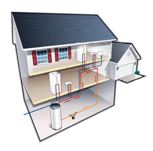Plumbing Topic: Domestic Water Recirculation Systems Part 1
|
The R. L. Deppmann Monday Morning Minutes series will focus on the plumbing portion of the new construction and building facility business for the next few months. The topics will be domestic water recirculating systems, pressure booster systems, volume and instantaneous water heaters, and mixing valves. I’ve had 6 job site visits in the last 2 months to help engineers, service contractors, and facility managers solve problems with domestic water recirculating systems. It seems this is a good place to start.
|
 |
A waste of time, health, money, and resources. Every one of us has experienced the frustration of running a shower or lav for seconds to many minutes while we wait for the hot water. “A waste of time” If a lavatory in your office runs colds water for 45 seconds before turning hot, do your employees wait? If they don’t wait, do they properly wash their hands? “A waste of health” If a shower takes a couple minutes before getting warm, think of the water going down the drain.
“A waste of money and resources” For these reasons, most plumbing codes and engineering office standards require some form of domestic water recirculating systems.
|
|
What flow rate is required? The whole idea of the recirculation system is to provide hot water quickly to the person at the fixture. If we start with hot water at the fixture, the piping system slowly loses temperature through the insulation. The flow rate of the recirc pump should be great enough to overcome the losses through the insulation. In order to determine the flow rate required you take the length of insulated pipe times the BTUH loss per foot and find the total BTUH. Now determine how much temperature loss you will allow. The higher the ΔT you choose, the lower the temperature and the more likely you are to waste water.
|
 |
|
|
Example: suppose you have a 4 story commercial building. Let’s assume the domestic hot water supply is a total length of 1000 ft. That is the entire length of pipe on all of the floors. Let’s also assume an average of 15 BTU/hr/ft of loss through the supply pipe insulation. Now let’s assume the recirc piping is 300 ft total at an average of 10 BTU/hr/ft of loss. What flow rate is required for a 10 degree ΔT? What flow rate is required for a 5 ΔT?

|
|
The answer will be given next Monday, July 25, 2011
|

Disclaimer: R. L. Deppmann and it’s affiliates can not be held liable for issues caused by use of the information on this page. While the information comes from many years of experience and can be a valuable tool, it may not take into account special circumstances in your system and we therefore can not take responsibility for actions that result from this information. Please feel free to contact us if you do have any questions.




